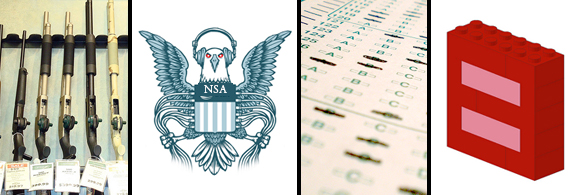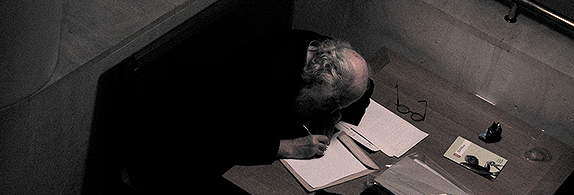Getting Real in 2014

As we roll into the start of what by all predictions will be an awful and meanly volatile political season in New Mexico and the nation this year, perennial questions will arise and need to be addressed anew.
When analyzing legislation or administrative actions, the first question to ask is who benefits and who is burdened?
Second, it is important to keep in mind that perhaps the world is not divided in half with only two viable views of reality and of what’s right and wrong. There could be more, many more, points of view to explore and learn from than just the plus and the minus, the black and the white and the nondescript gray, the right and wrong, the either and the or. Is the world pluralistic or dualist? Is there a spectrum of possibilities or merely two opposites?
Third, while trying to keep real this year we must come to terms with the question of questions: Do good ends ever justify cruel, oppressive, or exploitive means? When analyzing politics, it is crucial to ask this simple question: Who is advancing kindness, empowerment, health, inclusion, and peace, and who advancing private gain, strife, illness, oppression, disrespect, and indifference to the suffering of others?
Getting real in 2014 means understanding consequences and cutting through ideology, blather and political gamesmanship.
Take gun control. Who benefits and who is burdened by laissez faire, anything goes gun laws, laws which have allowed, under the protection of Constitutional interpretation, this country to be literally awash in firearms, some of them so inherently dangerous that simply pulling their triggers releases a fusillade of bullets? An estimate several years ago calculated that the United States harbored more than 270 million civilian owned guns of all kinds. Another more recent estimate has the number at 300 million and rising by 10 million a year.
The United States has overwhelmingly the largest civilian gun ownership in the world. We have slightly more guns than we do passenger vehicles, some 270 million cars and trucks as of five years ago.
Guns are so common in our country that we have come to take them as casually as we take our cars. Yet when you add up total deaths caused by fire arms, excluding accidents, you combine 19,392 suicides with 11,070 homicides and arrive at a total of 30,462 in 2010. And then you must add the accidental deaths. From 2005 to 2010 almost 4,000 people died in firearm accidents. Compare that to the 34,925 Americans in 2010 who were killed in auto accidents and you can see a truly horrifying similarity.
In our society, and over much of the world, automobiles have become objects of necessity. Our world is geared to automobiles. And even if we managed to change fuel sources, those new fuels will surely power passenger vehicles. Guns, on the other hand, are not objects of necessity in our country or around the world. Though in the United States they are treated as if they were. You do not need a gun to go about your daily life, to find a job, to go shopping, or to take your child to school. Guns are objects of choice, not necessity. And these objects of choice kill off as many of us in our country – overwhelmingly with malice and intent – as do cars and trucks as objects of necessity do – overwhelmingly by accident.
So the question must be asked: Who benefits from a culture in which political propaganda and manufacture’s advertising and public relations create a climate of fear and a sense of Constitutional right to propagate the normalcy of weapons designed for one thing and one thing only – to kill or maim another creature? Who benefits and who is burdened by a culture which treats guns more casually than it treats cars?
It can’t be the general public. It can’t be school children across the country, now including Roswell, New Mexico. It can’t be people killed by mad men who can get a high powered automatic weapon faster and more easily, apparently, than they can get a car. Yes, guns have been used in self-defense, some 67,000 times a year from 2005 to 2011, according to National Crime Victimization Survey. We don’t know if the guns were fired, if they killed innocent people or anything about the circumstances in which they were “used.” We do know that when you compare 300 million guns to 67 thousand so-called self-protection events, a ludicrous discrepancy appears. So who benefits by a culture in which guns have been normalized to such a degree that people leave loaded weapons lying around their homes? And who is burdened by this normalization? Who makes the money? Who galvanizes political gain from defending the gun industry from regulation?
It’s relatively easy to choose sides but very difficult to see and choose among a wide range of possibilities which, more often than not, are more useful and humane than simple either/or answers. Take marriage equality and related issues, such as child rearing by same sex couples.
Of all things in this life, love can inhabit and ennoble any person, any relationship, any choice, any situation. It is the universal goodness. It excludes no one. Love is infinitely plural. It does not exist along a spectrum with itself at one end and hate at another. Hate is the opposite of love; it is not joined to it. When hatred is so intense toward certain people that it excludes the possibility of love, one can’t help but see for oneself what hate really is. Hate excludes. Love includes. Where there is a plurality of hate, there is a plurality of exclusion. Where there is a plurality of love, there is a plurality of inclusion.
Marriage equality and child rearing by same sex couples, as manifestations of the universality of love, often find themselves in the middle of the social tangling and confusion that appears along the spectrum of hate. Hate tends to sanction one thing which it, paradoxically, pretends to love. Love itself tends to sanction all its manifestations. When analyzing public policy and trying to get real, it’s important to keep in mind that love is not associated with harm or abuse. Love isn’t harmful. What’s harmful is something other than love. When love is labeled as harmful it is usually by those who hate, and hate categorically.
Obviously good ends never justify evil means, because the means determine the ends. Spying on Americans to keep them safe, does not keep them safe from the spies and from those who could, in the future, use the spy’s surveillance tools to do horrible harm. While protecting ourselves from people who hate us is worthy end, doing so by assassinating the leaders of hate in such a way that murders innocent civilians along with them, taints the worthy end almost beyond recognition. Is sending in foot soldiers somehow nobler than sending in drones? That’s hardly the point here. War and hate and killing are always wrong. Self-defense becomes monstrous when monstrous means are used.
But it is a much simpler task, I think, to ascertain who is advancing kindness, peace, health and the public good as opposed to who is advancing private gain, strife, illness, and suffering in the long run.
Ah, but you ask, isn’t this kind of thinking a form of dualism? I’d answer by saying, it’s a form of addition. Does “education reform,” as it is currently conceived by Republicans across the country and in New Mexico, add up to a public good? I’d say it doesn’t. And it’s not because I’m a Democrat. Public money is being used to stimulate the private gain of corporate entities who seek to take over the functions of public education for their own benefit. Are they advancing public empowerment, peace and inclusion? Are they using means that intimidate and denigrate teachers, means that burden children with performance stress over learning fulfillment? Are they using means that create a problem that can only by solved by their profit-making solutions, means that tear down and defund an age old system that has served the children of our state quite well over the decades and replace it with profit-making programs of private companies beyond public oversight and regulation? Yes. And that just doesn’t add up to anything good in the public interest.
Is education failing in New Mexico? When that question is asked your answers will be by necessity pluralistic. Are teachers and administrators failing in New Mexico out of malice or malingering? No. Are some schools “better” than others? Probably. Is that fixable? Of course it is, if you want to fix it. Is the funding formula for New Mexico’s school children failing New Mexicans? Of course it is. The National Education Access Network has found that “New Mexico has had some of the deepest education spending cuts since the recession began and is one of just 13 states where spending per student is still at least 10 percent below 2008 levels.” That’s a decrease of some 11.4 percent when adjusted for inflation. Are we impoverishing our schools, county by county, by not charging sufficient property taxes, gross receipt taxes and manufacturing taxes? Yes. New Jersey is ranked second in the nation when it comes to spending per student. New Mexico ranks 25th; not bad for the poorest state in the union, but not great. New Jersey charges as much as four to five times the amount of property taxes as New Mexico with much of the revenue going to public education.
Does New Mexico need education reform? Does it need to fund teachers to be updated annually in their subject matter? Does it need to see teachers as scholars rather than functionaries and classroom managers? Does it need to spend public money on educational privatization? What guarantees that business can do a better job educating our children than well paid, well respected public servants who are teaching scholars, not corporate employees? Which approaches advance empowerment, health and inclusion and which advance private gain, disrespect, and the defamation and suffering of others?
Ward Abbott – 1945 - 2008

I’m sure most people in New Mexico, other than somewhat older poets perhaps, have never heard of the late Ward Abbott. But if you’re looking for altruists to admire, for those who advance kindness and empowerment of others with no fanfare and no hope for gain, Ward Abbott, an Albuquerque native, is the perfect person to start with.
A long time bookseller who helped turn UNM Bookstore, for a while, into a fine place to browse for those interested in the classics and philosophy, and verse. Ward’s passion and preoccupation was with poetry and those who write it. Never a man of means, always a worker who was happy with his “bowl of gruel,” as he’d say, Ward still managed to publish perhaps hundreds of poets out of his own pocket and on his own time. Simply put, he was a publishing saint to many people, giving them an audience when they needed it the most. And he was so self-effacing that he often just vanished into his publishing ventures.
Early on, he dreamed up the Penny Poetry Sheet, which was often laid out on newsprint. This was, of course, long before the computer and the private laser printer. He distributed the Penny poems all over the core of city on his daily walks and bus rides. He created a beautiful poetry bookmark while working at the UNM Bookstore. He reviewed countless books of poetry for magazines across the west. And he, most famously, published The Desert Review, which presented many poets including Keith Wilson and Larry Eigner. The first edition in l967 was stapled together his living room.
I knew Ward for many years and was a beneficiary of his publishing generosities and his wonderful conversation. Mysterious, funny, enormously kind, Ward was a man of books, a poet with a keen sense of minimalist power and also a man of the street as well, a walker, a smoker, a consumer of strong coffee, a native New Mexican and a man who would have probably given a starving poet his own bowl of gruel for the day.
I had the honor of doing a reading with him once at the Living Batch Bookstore. We often talked over plans to create an anthology of poems in appreciation of the life and work of Santa Fe poet Winfield Townley Scott.
Ward was always full of intellectual surprises. He was a collector of the works of A.E. Housman, the Cambridge University classics scholar who wrote The Shropshire Lad, a famous pre-World War I suite of darkly beautiful pessimistic poems for which he is most famous. Ward considered himself a “Housman completest,” someone striving to acquire all the printed works, in all their editions, of Housman’s output. Housman was the greatest Latin scholar of his day, and, some contend, of all time. To be a Housman completest meant having a working relationship with Housman’s translations and scholarly publications of Juvenal, Manilius, and Lucan, as well as Martial and other Roman poets, essayists and playwrights.
Ward’s own poetry had a Roman feel to it. In “The Funeral, for Winfield Townley Scott,” published in In Company: An anthology of New Mexico Poets after 1960, he wrote:
I see, under the canopy of death,
no flowers, no faces;
only a blur of colour
in which tired faces
and bright flowers
are gathered.
The poet is dead.
Friends have wept.
They depart
Into his absence.
Who would have known that the deeply tanned, slightly hunched walker billowing cigarette smoke behind him, trudging up and down Central Avenue, often with a shopping bag of books was what is honorably referred to as “an independent scholar,” unattached to the world of tenure and faculty meetings, but a gentle conversationalist, a willing ear, an eager explorer of friendships and ideas, and a catalyst of other people’s talents none the less.
The Rio Grande Nature Center vs. The Rio Grande Vision

Albuquerque Mayor Richard Berry is building an M.O. of ignoring precedent and reasoned opposition. He seems to have a contemptuous view of history and continuity. He breaks with long tradition when he refuses to have key administrative functionaries confirmed by the City Council at the beginning of his second term. He turns a deaf ear to the roaring complaints against the Albuquerque Police Department and its history of abuse and shootings of all too often unarmed “suspects.” And he completely blows away an over 40-year history of preserving the Rio Grande Valley State Park and the Rio Grande Bosque as a nature habitat with his ill-conceived Rio Grande Vision. And, to top it off, he ignores the voices of nearly 400 people who oppose his Rio Grande Vision on grounds of history and habitat.
Briefly put, the Rio Grande Vision’s view of the Middle Rio Grande Bosque is as a manicured urban park which purports to give more access to the Bosque and its wildlife but in reality creates situations in which wildlife will vanish. Its viewing platforms, benches, wide pathways, and picnic areas will denude the Bosque of creatures rightly annoyed by, and afraid, of humans.
In stark contrast to this plan, and embodying the sentiments, political activism, and legally binding planning documents generated since the early l970s, is Antoine Predock’s Rio Grande Nature Center. This award winning building strives to be as invisible and unobtrusive as a building can be. It protects wildlife from human intrusion, while still giving us a chance to appreciate the beauty of wild creatures who are safe in the Rio Grande preserve.
Predock called the building an example of his “engineering aesthetic.” The entrance way is a long piece of corrugated culvert which gives visitors the sense of being in a special, almost secret, place. Inside are huge viewing windows onto duck ponds and the Candelaria wetlands. Built in l982, the Nature Center is one of the great works of contextual design in the United States. Predock is internationally known for his “portable regionalism,” buildings that adapt to their physical and cultural contexts. He designed a building near the Bosque that acts basically as an architectural blind behind and within which humans can respectfully satisfy their curiosities, read up and learn about wildlife in the Bosque through interpretive exhibits, and savor the sense of doing the right thing which means, in this case, endangering no living thing within the Rio Grande State Park.
It’s important to stress that the Nature Center is built outside the Bosque, not within it.
Most of the great architecture and design in New Mexico is contextually sensitive, respectful of its place and what it means and has meant over time. So why isn’t the Mayor’s Rio Grande Vision a contextual work, instead of a brazen invasion of wildlife habitat? Why does it ignore the Middle Rio Grande Ecosystem Bosque Biological Management Plan and the city’s own long standing Bosque Action Plan which was adopted by the City Council in January l993?
Unhappily for us, it seems that’s the way Mayor Berry operates – ignoring tradition, ignoring the historic contributions of generations of Albuquerque citizens, ignoring context, and bulldozing his way into the future while flattening the past.
Let’s make it our responsibility to turn the bulldozer off.




Responses to “Provincial Matters, 1-20-2014”